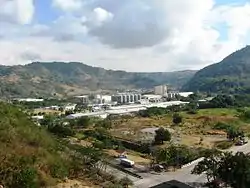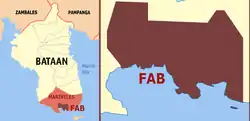Freeport Area of Bataan
The Freeport Area of Bataan (FAB), formerly Bataan Export Processing Zone (BEPZ) from November 20, 1972 to June 30, 2010, is a special economic zone in Mariveles, Bataan, Philippines. It was envisioned by Congressman Pablo Roman, Sr., a representative from Bataan, who authored Republic Act 5490 designating the said location as the first free trade zone in the Philippines.[1][2]
Freeport Area of Bataan | |
|---|---|
Freeport Zone | |
 Freeport Area of Bataan | |
 | |
 | |
.svg.png.webp) FAB Location within the Philippines .svg.png.webp) FAB FAB (Philippines) | |
| Coordinates: 14°26′26.9″N 120°30′53.7″E | |
| Country | |
| Region | Central Luzon (Region III) |
| Province | Bataan |
| Municipality | Mariveles |
| Time zone | UTC+8 (PST) |
| Website | afab |
Background
The Freeport Area of Bataan is the first "free trade zone" in the Philippines established through the enactment of Republic Act No. 5490 by the Congress of the Philippines. The freeport was envisioned by the late Congressman Pablo Roman, father of former Bataan Governor Ding Roman. The freeport is currently operated and managed by the Authority of the Freeport Area of Bataan (AFAB), a government agency under the Office of the President of the Philippines (formerly by Philippine Economic Zone Authority (PEZA), an agency attached to the Department of Trade and Industry (DTI) before the turnover of operations and management to AFAB on June 30, 2010).
FAB is located in a cove at the southern tip of the Bataan Peninsula. It is about 172.3 kilometers from Manila via the North Luzon Expressway, Jose Abad Santos Avenue (Olongapo-Gapan Road), and Roman Superhighway. It has a total land area of 153.9 km2 or 1,742.48 hectares (4,305.8 acres) representing 12% of the total land area of Bataan. Of this, about 35% consist of the pastureland, 4.6% of forestland, 3.8% agricultural lands and the remaining 6% for residential and industrial use.[3] It is home to a Filipino community speaking a Languages of the Philippines called Mariveleño. According to the 2000 census, it has a population of 85,779 people in 19,460 households.
Agricultural resources include rice, mangoes, legumes, vegetables and coffee. It also has aquatic resources like round scads, grouper, mussel, and abalone; mineral deposits of granite and basalt and forest products like vines and bamboo.
The tennis balls used in the Wimbledon Grand Slam are made in FAB.[4]
Scope
The FAB covers 2 barangays of Mariveles namely Barangays Maligaya (Pizarro) and Malaya (Quadro).